Menus
- Alternative boxes
- Both models are beautiful
- Serious and sober versus classic and playful
- Suzuki GT 550 is more invigorating
- Similar driving behavior of the two Suzuki cars
- Technical data Suzuki GS 550 E
- Frank Lutz, owner of the Suzuki GS 550 E.
- Technical data Suzuki GT 550
- Andreas Issel, owner of the Suzuki GT 550

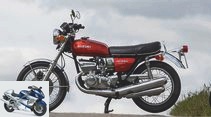
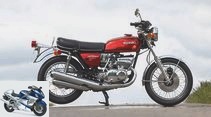
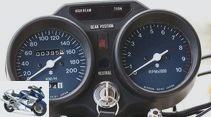
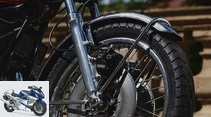
30th photos
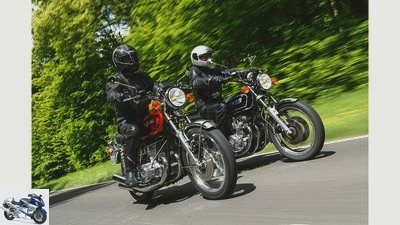
www.
1/30
In the mid-1970s, Suzuki was pretty late in setting the course for the future. It was not until 1976 that Hamamatsu became the last of the four major Japanese motorcycle manufacturers to use four-stroke models.
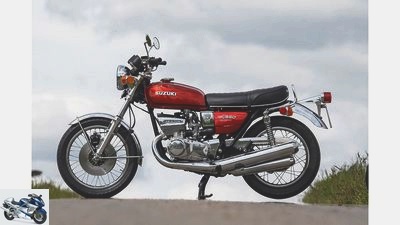
www.
2/30
Although the papers of the US model show 1975 as the year of birth, it is technically the same as the German 1976 model.
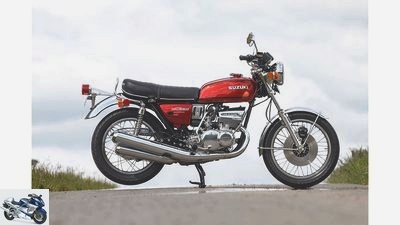
www.
3/30
Which means that Andreas ’GT 550 cylinders also have four instead of two transfer ports and a Nikasil-like SCEM coating instead of shrunk cast liners.
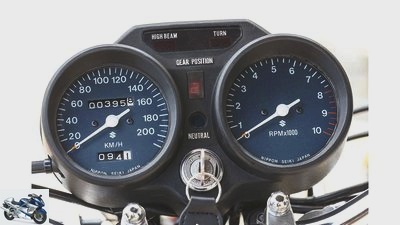
www.
4/30
Andreas reset the speedometer to zero after the restoration. The GT also has a gear indicator, but here it is in a smaller window.
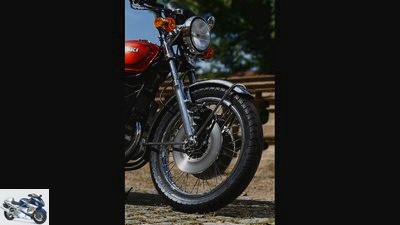
www.
5/30
At the front, the wire-spoke wheels of the Suzuki GT 550 have double disc brakes with a diameter of 290 mm.

www.
6/30
The facelift also affected the manifolds that no longer had any connecting pipes.
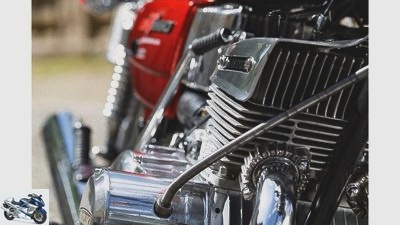
www.
7/30
The revision brought hard chrome-plated piston rings, an optimized carburetor actuation and a newly designed air filter, which was accessible from both sides from then on.
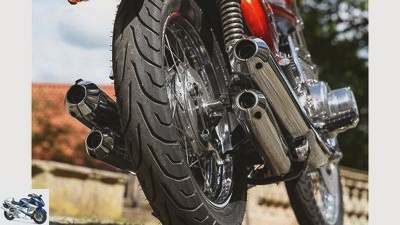
www.
8/30
Good for symmetry: 3-in-4 exhaust system.
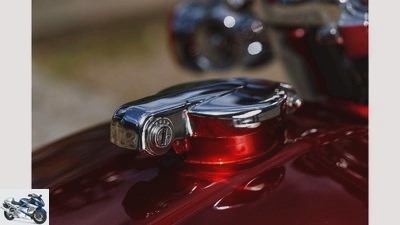
www.
9/30
Sparkling candy orange in the original metallic color “Mojave Copper” contrasts with the gleaming chrome of the lockable fuel cap on the GT 550.
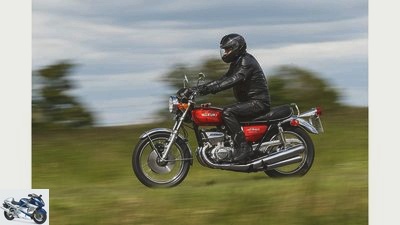
www.
10/30
You sit upright on the GT 550, but the knee angle is a little more relaxed than on the GS 550.
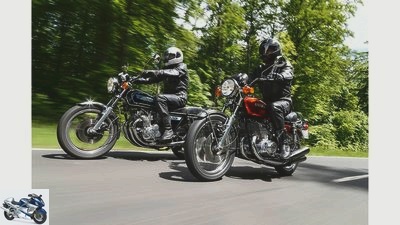
www.
11/30
In direct comparison, the GT, which is somehow more invigorating.

www.
12/30
The GT not only makes more noise than the smooth GS, but also demands more from the less experienced two-stroke driver – and therefore rewards with a more intense driving experience than the four-cylinder GS 550, which purrs naturally in every situation.

www.
13/30
Andreas Issel, owner of the Suzuki GT 550: "Of course I also like four-stroke engines, no question about it. When it comes to classic motorcycles, however, it is clearly the two-stroke engines from the 1970s that fascinate me. I especially like the three-cylinder Suzukis. After restoring a water buffalo, I really wanted a GT 550 as well. I built this one from a pile of scrap. But the effort was worth it, I think the GT 550 with its characteristic engine is wonderful. In addition, the lively 550er is much more manageable than the Buffel, for me it is the ideal complement to the GT 750."
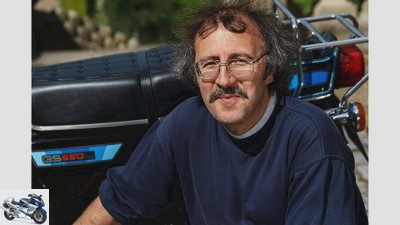
www.
14/30
Frank Lutz, owner of the Suzuki GS 550 E: "Two or four stroke? For me as a Suzuki maniac, both concepts have their charms. In everyday life, however, I prefer a GS Suzuki. In particular, the frugal 550, which I initially only bought out of reason. More powerful than one of my GS 400s, but noticeably easier to handle and not that much slower than the GS 750, the 550 is actually the golden mean in Suzuki’s GS series for me. With its outstanding reliability and average consumption values of around four liters, it has long since convinced me, and today I am really attached to my GS 550."
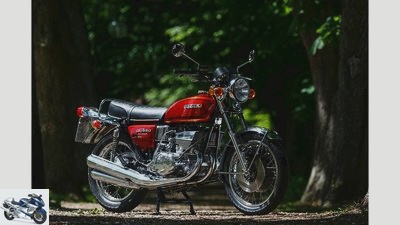
www.
15/30
The Suzuki GT 550 magically attracts attention with its shiny chrome and the shiny candy orange metallic called “Mojave Copper”.

www.
16/30
Andreas bought the Suzuki GT 550 as a heap of junk and painstakingly transformed it into a true-to-the-original piece of jewelry.
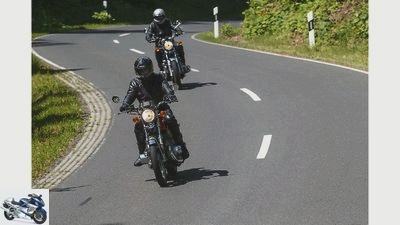
www.
17/30
This newly developed GS generation was a direct hit, both the GS 750 and the two-cylinder GS 400 sold brilliantly. And so Suzuki added the GS 550 the following year in order to close the large gap between the existing models.
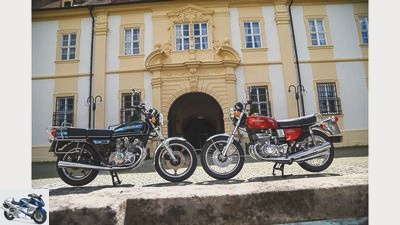
www.
18/30
Andreas Issel and Frank Lutz see it – like most today – but completely relaxed. The two Suzuki aficionados have long answered the question about two or four-stroke engines with an “as well as”. The fact that Andreas ‘Herz beats a little faster with the three-cylinder two-stroke models is demonstrated here with his newly built GT 550.
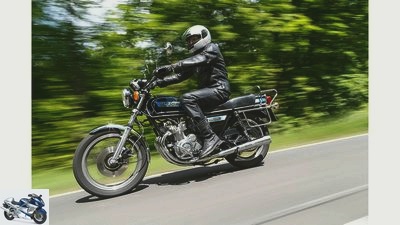
www.
19/30
The condition of Frank’s GS was also pretty sad when he bought it around 20 years ago for 150 marks – with 170,000 kilometers on the clock.
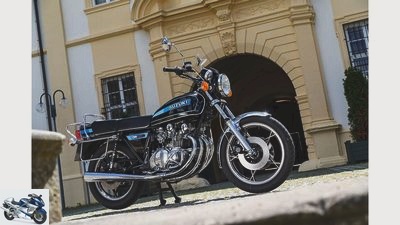
www.
20/30
While the chrome-laden GT immediately captivates the viewer with its classic, playful lines, the candy paint or the spoked wheels, it takes a little longer to visualize the timeless elegance of the GS 550.
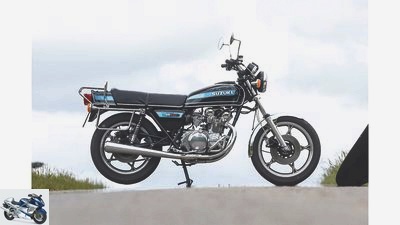
www.
21/30
In comparison, it looks more serious, more sober, although here too details like the wonderfully ribbed engine with its round camshaft covers or the characteristic cast rims with their polished edges are pleasing to the eye.

www.
22/30
In contrast to the short-stroke 750 GS, the 550 four-cylinder has a square bore / stroke ratio (56 x 55.8 mm) and the six-speed gearbox.
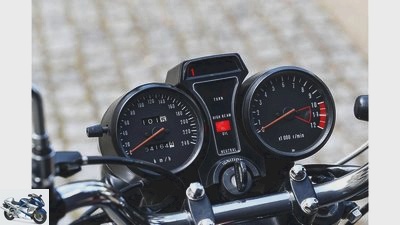
www.
23/30
While the “1” appears in the gear display, you have to think of the “2” when looking at the mileage – Frank’s GS 550 has really already run 254,000 kilometers.

www.
24/30
At the front, the Suzuki GS 550 E is equipped with double disc brakes.

www.
25/30
These double disc brakes have a diameter of 275 mm.
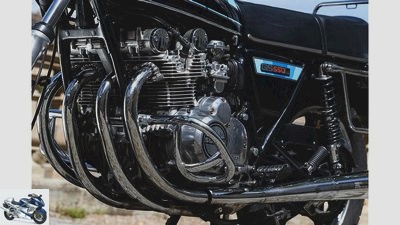
www.
26/30
Good for high speeds, which the 49 hp four-cylinder also needs to do real ballet. The two-valve engine only develops an energetic bite from 7000 revs, which lasts up to 10,000 rpm.
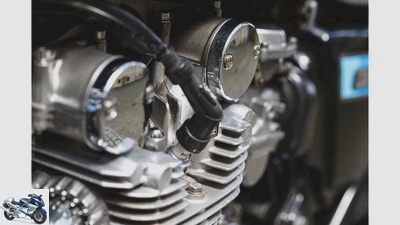
www.
27/30
Typically GS: round camshaft covers.
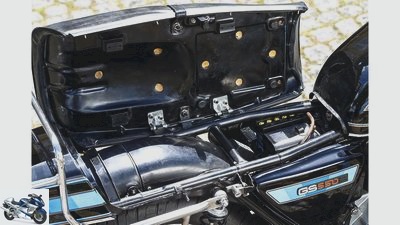
www.
28/30
The battery is easily accessible under the folding bench.
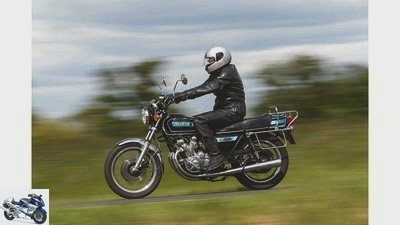
www.
29/30
Frank prefers to be comfortable, which is why he has installed high handlebars.

www.
30/30
At the end of a wonderful day in the Steigerwald, everyone agrees that mid-range bikes like the 550 Suzuki are wrongly overshadowed by the large-volume models. And the question of the best drive concept probably cannot be answered by any regulars’ table in the world. But, like with beer, from your own taste.
On the move with the Suzuki GS 550 E and Suzuki GT 550
Alternative boxes
Content of
Two or four stroke? In 1977, Suzuki was the only motorcycle manufacturer to offer both drive concepts in the middle class. The same displacement, almost the same weight and performance – the Suzuki GS 550 and Suzuki GT 550 are worlds apart?
S.In the mid-1970s, uzuki was pretty late in setting the course for the future. It was not until 1976 that Hamamatsu became the last of the four major Japanese motorcycle manufacturers to use four-stroke models. This newly developed GS generation was a direct hit, both the Suzuki GS 750 and the two-cylinder Suzuki GS 400 sold brilliantly.
Buy complete article
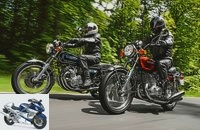
On the move with the Suzuki GS 550 E and Suzuki GT 550
Alternative boxes
From a pile of junk to an original piece of jewelry
Andreas Issel and Frank Lutz see it – like most today – but completely relaxed. The two Suzuki aficionados have long answered the question about two or four-stroke engines with an “as well as”. The fact that Andreas ‘heart beats a little faster with the three-cylinder two-stroke engine is demonstrated here with his freshly built Suzuki GT 550. He bought it as a pile of junk and painstakingly transformed it into a true-to-original piece of jewelry.
The condition of Frank’s Suzuki GS 550 was also pretty sad when he bought it around 20 years ago for 150 marks – with 170,000 kilometers on the clock. But the four-cylinder ran flawlessly, and the original paint set was okay. It still shines so flawlessly that you can hardly believe the 254,000 kilometers on the odometer. “I have actually never opened the engine completely, only the timing chain and some hardened Simmerrings I had to replace up to now,” says the radio and television technician making no secret of his preference for the reliable GS models. In the meantime, Frank has grown as fond of what was once a sensible purchase for everyday use as Andreas did to the Suzuki GT 550.
Both models are beautiful
So emotionally it is tingling here and there, at least with Frank and Andreas. Which is, of course, sausage for the Classic editor. My motorcycle socialization took place neither on a two-stroke nor a Suzuki, but on a Kawasaki Z 550 B. Which is why the two Suzuki maniacs are all the more excited about my driving impressions. Well, first of all I want to know a little more about your Suzuki GS 550 and Suzuki GT 550.
I definitely think both 550s are beautiful. Especially the Suzuki GT 550 with its shiny chrome and the shiny candy orange metallic called “Mojave Copper” magically attracts my eyes. Although the papers of the US model show 1975 as the year of birth, it is technically the same as the German 1976 model. Which means that Andreas ’GT 550 cylinders also have four instead of two transfer ports and a Nikasil-like SCEM coating instead of shrunk cast liners. In addition, the revision brought hard chrome-plated piston rings, an optimized carburetor actuation and a newly designed air filter, which was accessible from both sides from then on. The facelift also affected the manifolds that no longer had any connecting pipes. Thanks to the coated cylinder, the oil pump could also be set leaner at the factory.
Classic meeting in Sinsheim on October 4th
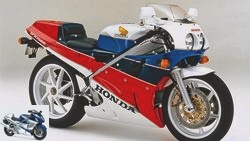
classic
We reveal our absolute classics
The dream classics from MOTORRAD Classic
read more
www.jkuenstle.de
The Suzuki GT 550 magically attracts the eye with its shiny chrome and the glowing candy orange metallic called “Mojave Copper”.
This does not prevent the Suzuki GT 550 from smoking heavily from its symmetrically mounted 3-in-4 exhaust system. It’s understandable that Andreas prefers to play it safe after the restoration, after all, the two-stroke treble has hardly run since it was set up. So I approach the first few kilometers cautiously and delightedly listen to the two-stroke saws of the triple, which for me as a four-stroke biker are almost exotic. But he doesn’t like my reluctance at all, little progress is made below 4000 tours. Not least a result of the facelift, which focused on increasing the ease of turning. The 1976 model only achieved the nominal 48 hp at 7500 rpm, which is 1000 more than in previous years.
The pulling power has also suffered from this sportier set-up, the maximum torque is only available at 6000 tours. If you let the needle on the rev counter dance into higher regions, the GT moves ahead with its hearty three-cylinder tubes as befits its standing. In any case, Andreas lack Suzuki GT 550 does not show the effect described by Tester Klacks in the older models of running “like against rubber” from 6500 rpm.
Serious and sober versus classic and playful
Nevertheless, as a less experienced two-stroke driver, I always need a few more kilometers to adjust to the typical peculiarities of this working principle. At some point there comes the point at which the low braking effect in push mode no longer plays a role, the right gear is there in good time and I have put aside the idea of a Klemmer that I initially had with me. With Andreas ‘Suzuki GT 550 that was the case after refueling. Maybe I was only intimidated by his words about the high consumption (“it drinks like a hole”). Now, with the fuel tank full, I just let the 550 run, turn to seven-five, switch down in good time and enjoy the singing triple sound – well, please, it works, you just have to work a little more.
However, I don’t need any time to get used to Frank’s Suzuki GS 550. Here everything works as I have been used to since I was 18 years old. That’s why I head for a small parking lot first, put the Suzuki in the middle and let the slim four-cylinder engine work on me for a while. While the chrome-overloaded Suzuki GT 550 immediately captivates the viewer with its classic, playful lines, the candy paint or the spoked wheels, it takes a little longer to visualize the timeless elegance of the Suzuki GS 550. In comparison, it looks more serious, more sober, although here too details like the wonderfully ribbed engine with its round camshaft covers or the characteristic cast rims with their polished edges are pleasing to the eye.
www.
Frank prefers to be comfortable, which is why he has installed high handlebars.
In contrast to the short-stroke 750 GS, the 550 four-cylinder has a square bore / stroke ratio (56 x 55.8 mm) and the six-speed gearbox. Similarities with its big sister are the roller-bearing crank drive with needle bearing connecting rods and the two overhead camshafts that operate the valves via bucket tappets. Good for high speeds, which the 49 hp four-cylinder also needs to do real ballet. The two-valve engine only develops an energetic bite from 7000 revs, which lasts up to 10,000 rpm.
Nevertheless, the four-stroke engine, which is not particularly powerful according to the paper values (40 Nm at 7500 rpm), can be driven through the city in sixth gear at 50 km / h without hiccups. What is remarkable for me is the mechanical smoothness of Frank’s marathon machine, and the fine, high-frequency vibrations are absolutely tolerable after more than six circles around the world, especially since they seem less tingly to me than with the Suzuki GT 550. Andreas knows, not least about his water buffalo and Frank’s Suzuki GT 380 that he has not yet fully exploited the perfection potential of the 550 three-cylinder by means of meticulous fine-tuning.
Suzuki GT 550 is more invigorating
Nevertheless, in direct comparison, it is the Suzuki GT 550 that somehow seems more invigorating to me. Not only does it make more noise than the smooth Suzuki GS 550, it also demands more from me, the less experienced two-stroke driver – and therefore probably rewards me with a more intense driving experience than the four-cylinder GS 550, which purrs naturally in every situation. What I do not want to interpret the four-stroke Suzi negatively.
On the contrary, as a motorcycle just in case I – like Frank – would also choose the frugal and gentle four-stroke, even if it seems a bit boring. When I look at Andreas ’and Frank’s tense faces on my return, I suddenly realize that my thoughts so far have only been about the engines and the best drive concept. But that doesn’t exist, as I have to admit, at least not when comparing the Suzuki GS 550 and Suzuki GT 550.
Similar driving behavior of the two Suzuki cars
What the smoking and drinking joyful two-stroke engine lacks in everyday practicality, it makes up for with its very special character, which is no longer commonplace today. The four-stroke engine, on the other hand, has more of a dedicated butler, which many people find more personable in their daily dealings than a guy with annoying airs. Which character trait is more convenient for you, everyone has to decide for themselves. It’s nice when, like Frank and Andreas, you have the choice between two- and four-stroke engines. Because the driving behavior of the two Suzukis is not necessarily decisive for a pro or contra, the almost equally heavy Suzuki GT 550 and Suzuki GS 550 are too similar for that.
Both can be easily swiveled in curves, the Suzuki GT 550 with its lower center of gravity perhaps a tad more spontaneous than the Suzuki GS 550. Here and there you sit upright, with the four-stroke Suzi spoiling you with fluffier seating comfort, while its two-stroke sister allows the more comfortable knee angle. Almost equal in terms of the brakes too: With the retrofitted second disc at the front, Andreas’ GT brakes just as snappy and easy to adjust as the astonishingly vehemently gripping double disc of the GS 550. At the end of a wonderful day in the Steigerwald, Andreas, Frank and I agree that the middle class -Bikes like the 550 Suzuki are wrongly overshadowed by the large-volume models. And the question of the best drive concept probably cannot be answered by any regulars’ table in the world. But, like with beer, from your own taste.
Technical data Suzuki GS 550 E
www.
In comparison, it looks more serious, more sober, although here too details like the wonderfully ribbed engine with its round camshaft covers or the characteristic cast rims with their polished edges are pleasing to the eye.
engine
Air-cooled four-cylinder four-stroke in-line engine, compression ratio 8.6: 1, four Mikuni carburettors, Ø 22 mm.
Torque
40.2 Nm at 7500 rpm.
Displacement: 549 cc
Power: 49 hp at 9000 rpm
Power transmission
Multi-disc oil bath clutch, six-speed gearbox, chain drive.
landing gear
Double loop frame made of tubular steel, telescopic fork at the front, Ø 35 mm, two-arm swing arm with two spring struts, cast aluminum wheels, tires 3.25 H 19 at the front, 3.75 H 18 at the rear, double disc brake at the front, Ø 275 mm, disc brake at the rear, Ø 275 mm.
Weight with a full tank: 218 kg
Top speed: 184 km / h
Construction time: 1977 to 1980
New price: 5690 Mark (1977 model)
Frank Lutz, owner of the Suzuki GS 550 E.
www.
Frank Lutz is the owner of the Suzuki GS 550 E..
"Two or four stroke? For me as a Suzuki maniac, both concepts have their charms. In everyday life, however, I prefer a GS Suzuki. In particular, the frugal 550, which I initially only bought out of reason. More powerful than one of my GS 400s, but noticeably easier to handle and not that much slower than the GS 750, the 550 is actually the golden mean in Suzuki’s GS series for me. With its outstanding reliability and average fuel consumption of around four liters, it has long since convinced me, and today I am really attached to my Suzuki GS 550."
Technical data Suzuki GT 550
www.
Although the papers of the US model show 1975 as the year of birth, it is technically the same as the German 1976 model.
engine
Air-cooled three-cylinder two-stroke in-line engine, compression ratio 6.8: 1, three Mikuni carburettors, Ø 28 mm.
Torque
48 Nm at 6000 rpm.
Displacement: 543 cc
Power transmission
Multi-disc oil bath clutch, five-speed gearbox, chain drive.
landing gear
Double loop frame made of tubular steel, telescopic fork, Ø 35 mm, two-arm swing arm with two spring struts, wire-spoke wheels, tires 3.25 H 19 at the front, 4.00 H 18 at the rear, disc brake at the front, Ø 290 mm (standard), drum brake at the rear, Ø 180 mm.
Weight with a full tank: 214 kg
Top speed: 178 km / h
Construction time: 1972 to 1977
New price: 1972 to 1977
Andreas Issel, owner of the Suzuki GT 550
www.
Andreas Issel is the owner of the Suzuki GT 550.
"Of course I also like four-stroke engines, no question about it. When it comes to classic motorcycles, however, it is clearly the two-stroke engines from the 1970s that fascinate me. I especially like the three-cylinder Suzukis. After restoring a water buffalo, I really wanted a Suzuki GT 550. I built this one from a pile of scrap. But the effort was worth it, I think the GT 550 with its characteristic engine is wonderful. In addition, the lively 550er is much more manageable than the Buffel, for me it is the ideal complement to the GT 750."
Related articles
-
On the move with Suzuki GT 750 and Suzuki GS 750
fact 37 pictures www.factstudio.de 1/37 With the GT 750 and GS 750, Suzuki had two attractive alternatives in its range, … www.factstudio.de 2/37 The cockpit …
-
Photos: Final Suzuki GS 550 Katana A late acquaintance 30 years ago Suzuki presented the Katana series. However, it was not the…
-
On the move with the Suzuki GS 400
18th photos 1/18 1989: Drilled to 487 cm³, the GS 500 E starts with 46 HP. Its two-valve engine is also based on that of the GS…
-
On the move: comparison of the Honda CB 500 Four and Suzuki GT 550
Jahn comparison test classic On the move: Honda CB 500 Four and Suzuki GT 550 Contents of The Honda CB 500 Four and the Suzuki GT 550 share a fate: …
-
On the move with the Scott Model 3S
Nakamura 10 pictures Nakamura 1/10 Scott Model 3S – water-cooled in-line three-cylinder two-stroke engines from 1934. Nakamura 2/10 With a twist grip on the left …
-
Archive cult bike Suzuki GS 750 Amazingly mature performance Judging by the fact that Suzuki only launched four-stroke engines under massive pressure, the …
-
On the move with Suzuki RV 50, RV 75, RV 90, RV 125
Wolf 22 pictures Wolf 1/22 With new tire sizes 130 / 80-18 at the front and 180 / 80-14 at the rear, the VanVan drives more precisely. Wolf 2/22 The RV is available in all …
-
Suzuki RG 500 and Suzuki GSX-R 750 in comparison
MOTORRAD CLASSIC on the move: Suzuki sport motorcycles 1984 Competitors: Suzuki RG 500 and Suzuki GSX-R 750 Content of Suzuki presented the…
-
On the move with the Honda CB 900 F Bol d‘Or, Honda CBX, Kawasaki Z 1000 ST and Kawasaki Z 1300
Arturo Rivas 45 pictures Arturo Rivas 1/45 Six against four for first: Honda CBX and Honda CB 900 Bol d’Or. Arturo Rivas 2/45 Honda CBX. Arturo Rivas 3/45 …
-
Honda, Yamaha, Suzuki, Kawasaki and KTM
Manufacturer 16 pictures 1/16 2/16 3/16 4/16 5/16 6/16 7/16 8/16 9/16 10/16 11/16 12/16 13/16 14/16 15/16 16 / 16 Honda, Yamaha, Suzuki, Kawasaki and KTM The …